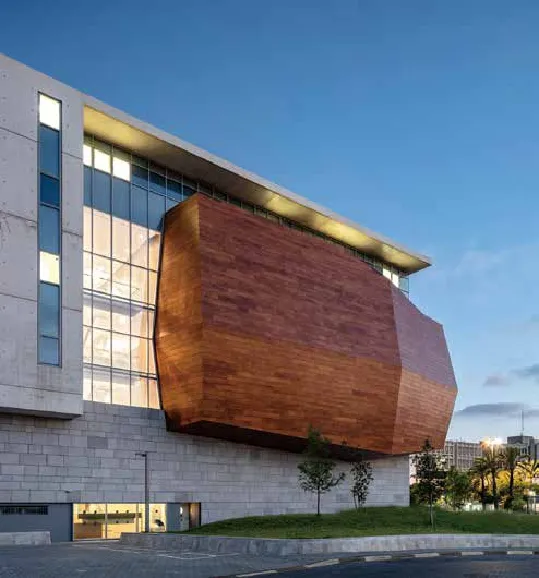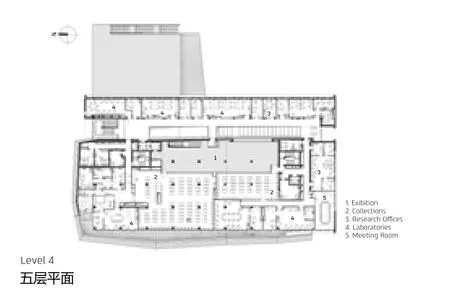斯坦哈特自然历史博物馆
2018-11-02MichalKimmelEshkolot,EtanKimmel,IlanCarmi等
建筑设计:基梅尔·埃谢科罗特建筑事务所
设计团队:Michal Kimmel Eshkolot , Etan Kimmel,Ilan Carmi, Limor Amrani
主持建筑师:Limor Amrani
业主:特拉维夫大学
面积:地面10 000 平方米,地下14 000 平方米
结构工程:拉哈特工程协调管理有限公司,
Eliezer Rahat, Daniel Rahat
承包商:Rom-Geves, Shitufit
景观设计:Braudo Maoz
照明设计:Shiri Ziv
摄影:Amit Geron
Architecture: Kimmel Eshkolot Architects
Design team : Michal Kimmel Eshkolot , Etan Kimmel, Ilan Carmi, Limor Amrani
Architect in charge: Limor Amrani
Client: Tel Aviv University
Area: above ground: 10 000 m2; Underground parking: 14 000 m2
Structural engineering: S.BEN-ABRAHAM Engineering
Construction manager: E.D. Rahat Engineering Coordination and Management Ltd.Eliezer Rahat, Daniel Rahat
Contractors: Rom-Geves, Shitufit
Landscape architecture: Braudo Maoz
Lighting Design: Shiri Ziv
Photographer: Amit Geron
新的博物馆将成为特拉维大学自然历史类收藏品的新家,该建筑设计包含展览和研究两种功能。通常未展出的收藏品都会放置在一个大木箱里——珍贵的植物和动物标本储存箱。设计师正是借鉴了标本箱这一形象,将建筑体打造成一个神秘的宝箱,邀请人们进入参观。盒子式建筑体象征着永恒,兼具历史与未来两种象征意义。建筑立面覆盖着工业木板,这样的设计可以保护收藏品,减少气候对藏品的影响。
博物馆位于特拉维大学植物园的入口处,设计师为此特意建造了一个新的入口通道,便于通达博物馆,同时,引导人们将花园和博物馆结合参观。建筑物如同悬浮在地面上,将花园的景色展现给路人。博物馆展区分布较广,一部分暴露在阳光下,通过斜坡与中庭相连,另一部分则位于较暗的房间内。这些坡道都设计较宽,且坡度较缓,方便游客(包括残疾人士)进入参观,同时体验不同的空间氛围。博物馆楼顶有露台,在这里人们可以俯瞰整个植物园,然后直接前往公共广场,继续游览花园。
研究实验区位于博物馆的上层,这样的设置方便研究人员能够看顾所有的馆藏。研究人员的通道是单独设置的,与游客的游览通道分开。但在通道最高处,游客和研究人员可以产生交集,进行交流。
As a new home for the spectacular natural history collections of Tel Aviv University, the building combines exhibition spaces and research activities. The collections, which were never before on display, were placed in a large wooden chest - a treasure box of valuable specimens offiora and fauna. The building enfolds the box and offers it to the public as an enigmatic object, invited to be explored. The box itself,which aspires to be of timeless qualities, concurrently ancient and futuristic, is covered with industrial wooden panels that highly insulate the collections and keep them under strict climate control.
The building is located at the entrance to the Botanical Gardens of Tel Aviv University, creating a new entryway for them and suggesting a combined visit to the gardens and to the museum. Floating above the ground, the building exposes the gardens and ‘pulls’ them to the street.
The exhibition of the museum spans across a diverse path which is in part exposed to daylight in ramps that open to the main atrium, and in part positioned within darker spaces. The ramps are wide and with minimal slope, allowing visitors, including those with disabilities, to walk up to the treasure box while experiencing the different spaces of the building. The visit ends on the rooftop terrace,overlooking the botanical gardens, from which visitors can go directly down to a public square and enter the gardens.
Placed in the upper levels, the research laboratories give researchers access to the entire collections.They are separated from visitors with independent circulation paths. However, within the treasure box,at the peak of the museum path, visitors and researchers are exposed to one another in series of choreographed encounters.
















